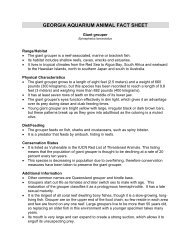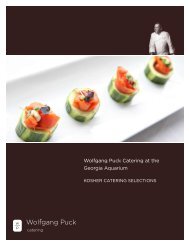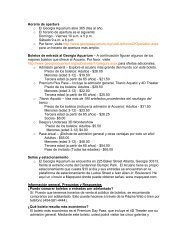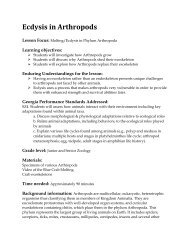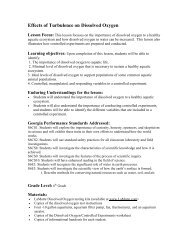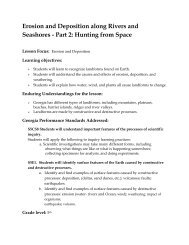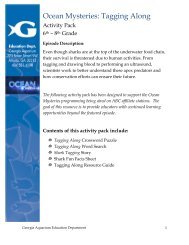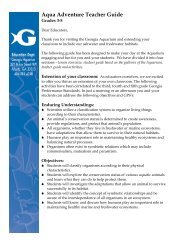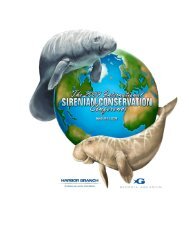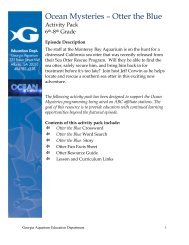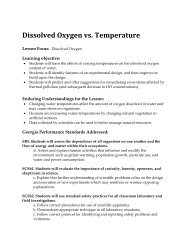Crazy Classification - Georgia Aquarium
Crazy Classification - Georgia Aquarium
Crazy Classification - Georgia Aquarium
You also want an ePaper? Increase the reach of your titles
YUMPU automatically turns print PDFs into web optimized ePapers that Google loves.
<strong>Crazy</strong> <strong>Classification</strong><br />
Lesson Focus: <strong>Classification</strong> and Dichotomous Keys<br />
Learning Objectives:<br />
• Students will learn what a dichotomous key is.<br />
• Students will explore how classification is used to make identifying an organism<br />
easier.<br />
• Students will create their own dichotomous key.<br />
• Students will classify animals according to their similarities and differences.<br />
Enduring Understandings for the Lesson:<br />
• <strong>Classification</strong> is a system to put things into orderly groups based on similar<br />
characteristics.<br />
• Taxonomists today use an eight-level system of classification to hypothesize how<br />
closely related living things are.<br />
• The more characteristics organisms share, the more closely related they are.<br />
<strong>Georgia</strong> Performance Standards Addressed:<br />
S7L1: Students will investigate the diversity of living organisms and how they<br />
can be compared scientifically.<br />
a. Demonstrate the process for the development of a dichotomous key.<br />
b. Classify organisms based on physical characteristics using a dichotomous key<br />
of the six kingdoms (archaebacteria, eubacteria, protists, fungi, plants, and<br />
animals).<br />
S7CS6: Students will communicate scientific ideas and activities clearly.<br />
c. Organize scientific information using appropriate simple tables, charts, graphs<br />
and identify relationships they reveal.<br />
Grade Level: 7 th<br />
Materials:<br />
• <strong>Classification</strong> Power Point presentation<br />
• Computer access with projector or Computer lab<br />
• Grapes, banana, orange, apple, peach, and plum<br />
• Baggies filled with buttons of various shapes, sizes, and colors (one per 5<br />
students)
• Pen/pencil, notebook paper<br />
• Outside access to school grounds, preferably with a water source nearby<br />
• Containers for holding collected samples<br />
• Containers with plastic bugs of various species (optional)<br />
• Microscopes<br />
Time Needed: 2 class periods with homework assignments<br />
Background Information:<br />
<strong>Classification</strong> was created to place animals into categories based on similar<br />
characteristics. We commonly classify things based on their usefulness, but biologists<br />
classify living things to answer many important questions, like number of species,<br />
characteristics of species, and relationships between species. Taxonomy is the science of<br />
describing, classifying, and naming living things. Classifying an organism allows<br />
scientists to give each organism its own scientific name and categorize them in an<br />
organized system. Dichotomous keys were created by using pairs of statements to<br />
eventually distinguish and therefore identify one single species of an organism from<br />
another. <strong>Classification</strong> is the tool that scientists use to identify organisms on Earth;<br />
however, it is still a growing system as newly-discovered organisms are continuously<br />
being found and added to this flexible system.<br />
From the days of Aristotle, living things have always been naturally grouped<br />
and these groups have changed from time to time throughout history. For most of the<br />
latter half of the twentieth century science recognized five kingdoms, grouping single<br />
celled organism with no true nucleus into one group. In the late 70’s, these single celled<br />
prokaryotes were split into the larger group Eubacteria and the much smaller and<br />
specialized Archaebacteria. In the early 90’s, a new view of kingdoms became popular<br />
by simply placing these cell based groupings into “domains” of Eubacteria,<br />
Archaebacteria, and Eukarya, and then having the four eukaryotic kingdoms be under<br />
the same domain. This allowed for a simple yet effective distinction at a cellular level.<br />
Taxonomy is and always will be the study of how living things are grouped<br />
together to understand the extreme biodiversity that life has to offer. Understanding<br />
how living things are different leads naturally to understanding how they are similar at<br />
the same time.<br />
Learning Procedure:<br />
1. (Day 1): Have a bowl of fruit filled with grapes, a banana, an orange, an apple, a<br />
peach, and a plum in the front of the room. Hold each item up, asking students<br />
what they think the items have in common Write their ideas on the board as they<br />
brainstorm.<br />
2. Show students the Power Point entitled CLASSIFICATION. Have them take notes<br />
on each slide until you reach the one titled Dichotomous Key. Lead students
through each stage of the dichotomous key as you hold up each piece of fruit<br />
fitting that description. (For example: Step 1: Fruits occur singly or Fruits occur in<br />
clusters of two or more…go to the next step until students have been able to<br />
identify each piece of fruit in the bowl).<br />
3. Place students into small groups and click to the next slide called “practice using<br />
dichotomous keys”. Clearing their desks of everything except for paper and<br />
something to write with, give each group a baggie of buttons in various shapes,<br />
sizes, and colors. Let students create their own dichotomous keys by placing the<br />
buttons into categories based on similarities. (You may want to leave the fruit key<br />
on the screen as a resource.) Have the students share their keys with the rest of<br />
their class, comparing their group findings to others.<br />
4. Have students go home and pick a messy area in their homes, yards, etc., to<br />
organize. For example, their closet, a junk drawer, their video game collection,<br />
music collection, etc. Let the students create a dichotomous key in which they<br />
place the items into categories based on similar characteristics.<br />
5. (Day 2): The Kingdoms: introduce students to the 6 kingdoms using the second<br />
part of the PowerPoint presentation and then practice identifying living things in<br />
different kingdoms.<br />
6. Take students outside on an excursion of their school grounds. Hopefully, you<br />
have access to a stream or body of water. Have students identify at least two<br />
species from each kingdom (use their imaginations with the bacteria and protists),<br />
View water samples under the microscope.<br />
7. Have the students’ journal their findings including descriptions, drawings, and<br />
characteristics of their samples that place them in a specific kingdom.<br />
Evaluation:<br />
‣ Provide students with a container of plastic bugs of various species. Have them<br />
create a dichotomous key putting the bugs into categories based on their<br />
similarities.<br />
Extensions:<br />
‣ Have students research an organism from each of the six kingdoms, presenting<br />
the research to the class in presentation.<br />
‣ Ask students to access the image section located on the Gray’s Reef and/or<br />
<strong>Georgia</strong> <strong>Aquarium</strong> websites and select ten fish and ten invertebrates. Ask them<br />
to create their own dichotomous key based solely on the physical characteristics<br />
of the organisms they can see in the images. They can then check for accuracy by<br />
comparing their key to an actual scientific key for marine fish and invertebrates.<br />
Resources:
‣ <strong>Classification</strong>: The three domain system<br />
o http://student.ccbcmd.edu/courses/bio141/lecguide/unit1/3domain/3dom<br />
ain.html<br />
o An introduction to another approach to the six Kingdoms focusing on the<br />
difference between eukaryotes, eubacteria, and archaebacteria.<br />
‣ How plants and animals differ<br />
o http://www.virted.org/Plants/PlantsDiffer.html<br />
o A focused website on the differences between plants and animals<br />
‣ Aquatic Plants<br />
o http://www.aquatic.uoguelph.ca/plants/index.htm<br />
o A look at forms of aquatic life and how they differ<br />
‣ Reef Fish<br />
o http://www.reef.org/<br />
o http://graysreef.noaa.gov/<br />
o http://www.georgiaaquarium.org/<br />
Lesson developed by: Erin Porter, Banks County Middle School, Homer, GA and<br />
Mihkel Allpere, <strong>Georgia</strong> <strong>Aquarium</strong><br />
This activity is a product of the Rivers to Reef Teacher Workshop sponsored by the <strong>Georgia</strong><br />
<strong>Aquarium</strong> and Gray’s Reef National Marine Sanctuary that the author participated in. For<br />
more information about this workshop, <strong>Georgia</strong> <strong>Aquarium</strong>, or NOAA Gray’s Reef National<br />
Marine Sanctuary, please visit our websites at www.georgiaaquarium.org or<br />
http://graysreef.noaa.gov/



